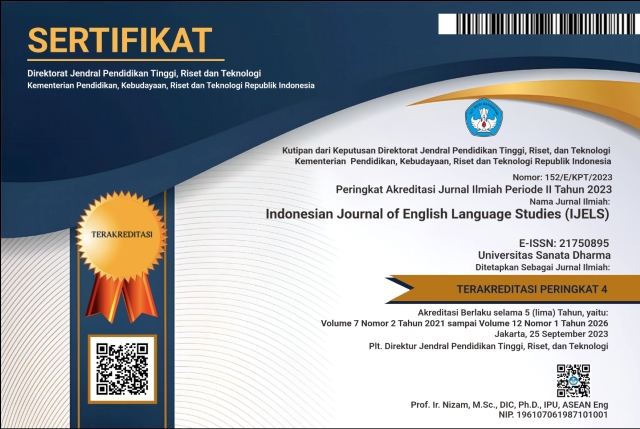The Ability of 10th-Grade Students to Use Past Tenses in Writing Narrative Text in SMA Kartika Jaya 1-4 Pematangsiantar
(1) Sanata Dharma University, Yogyakarta
(*) Corresponding Author
Abstract
This paper aims to investigate how well the 10th-grade students in SMA Kartika Jaya 1-4 Pematangsiantar able to use past tenses in writing a narrative text. This paper uses a descriptive quantitative method in which the data is the students’ narrative text consisting of 20 verbs in past tense and past perfect tense. Based on the investigation, it is found that the 10th-grade students in SMA Kartika Jaya 1-4 Pematangsiantar can use past tenses in writing narrative text and their ability is in the medium level. There is one student at the highest level or 2.86%, the students who are able at the medium level ability are thirty students or 85.72%, and the students who are able at the lowest level ability are four students or 11.42%. The mean is 67.57 and the standard deviation is 14.46 where the validity is 0.79 and the reliability is 0.88. By conducting this study, it is expected the teachers get an insight into measuring students’ ability to use past tenses in writing a narrative text.
Keywords
Full Text:
PDFReferences
Arikunto, S. (2010). Metode peneltian. Jakarta: Rineka Cipta.
Berk, L. M. (1999). English syntax: from word to discourse. Oxford University Press, USA. Bruce, I. (2008). Academic writing and genre: A systematic analysis. Bloomsbury Publishing.
Carnie, Andrew. (1999). Syntax. The University of Arizona, Arizona: Blackwell Publishing.
Elliott, J. (2005). Using narrative in social research: Qualitative and quantitative approaches.
Sage Publications.
Fiderer, A. (2002). Paragraph Power. Scholastic Inc.
Fleming, M., & Stevens, D. (2015). English teaching in the secondary school: Linking theory and practice. Routledge.
Gerot, L., & Wignell, P. (1994). Making sense of functional grammar: An introductory workbook. Queensland: Antipodean Educational Enterprises.
Harris, D. P. (1969). Testing English as a Second Language.
Hayden, R. E., Pilgrim, D. W., & Haggard, A. Q. (1956). Mastering American English: a handbook-workbook of essentials. Prentice-Hall.
H, Dauglas Brown. (1980). The Principle of Language Learning and Teaching. Urbana: University of Illions.
Hutchinson, Emily. (2005). Narrative Writing. Amsterdam: Saddleback Educational Publishing.
Hedge, T. (2005) Writing. Oxford: Oxford University Press.
Hegarty, Carol. (2006). Writing in English Context. Amsterdam: Saddleback Educational Publishing.
Indriastuti, Anik M. (2009). Buku Pintar Tenses. Jakarta: PT.Wahyu
Media. Jordan, R.R. (1999). Academic Writing Course. Chalbury: UK: Bluestone Press.
Knapp, P., & Watkins, M. (2005). Genre, text, grammar: Technologies for teaching and assessing writing. UNSW Press.
Nunan, D. (2003). Practical english. Language Teaching. New York: Mc Graw Hill.
Oshima, Alice, and Ann Hogue. (1999). Writing Academic English. Third Edition. White Plains, New York: Addison Wesley Longman.
Owens, Robert E. Jr: (2012). Language Development: An Introduction- 8th Edition, State University of New York, Geneseo: Pearson Education Inc.
Peterson, P. W. (1992). Changing Times, Changing Tenses: A Review of the English Tense System: Elementary/intermediate. English Language Programs Division, United States Information Agency.
Sells, Peter and Kim Jong Bok. (2007). English Syntax: An Introduction, Center for The Study Language and Information. Ohio. Standards Publication Ltd.
Shlonsky, U. (1997). Clause structure and word order in Hebrew and Arabic: An essay in comparative Semitic syntax. Oxford University Press.
Sudjana, N. (2005). Metode statistika. Bandung: Tarsito, 168.
Wishon, George E, and Julia M. Burks. (1980). Let’s Write English. Canada: Litton Educational Publishing, Inc.
Yakhontova, Y.V. (2003). English Academic Writing for Students and Researcher. Vietnam: ECA NIS College.
http://www.englishdirection.com/2013/18-04-2013. 13: 27P
http://dewaadivanwinata.wordpress.com/grammar/18-04-2013. 13: 35PM
http://reski0910.wordpress.com/all-about-english/functional-texts/what-is-analytical- exposition/is-smoking-for-us-example-of-analytical-exposition/18-04-2013. 13: 37PM
DOI: https://doi.org/10.24071/ijels.v7i1.1467
Refbacks
- There are currently no refbacks.

This work is licensed under a Creative Commons Attribution-ShareAlike 4.0 International License.
Indexed by
IJELS Journal Sinta 4 Certificate (S4 = Level 4)
We would like to inform you that Indonesian Journal of English Language Studies (IJELS) has been nationally accredited Sinta 4 by the Ministry of Education, Culture, Research and Technology of the Republic of Indonesia based on the decree No. Surat Keputusan 152/E/KPT/2023. Validity for 5 years: Vol 7 No 2, 2021 till Vol 12 No 1, 2026

This work is licensed under CC BY-SA.
Creative Commons Attribution-ShareAlike 4.0 International License
IJELS e-ISSN 2715-0895; IJELS p-ISSN 2442-790X
Indonesian Journal of English Language Studies (IJELS) is published twice a year, namely in March and September, by the English Language Studies (ELS) of the Graduate Program of Sanata Dharma University, Yogyakarta, Indonesia.


 IJELS p-ISSN:
IJELS p-ISSN: 















